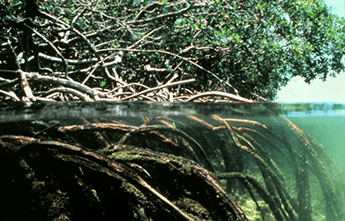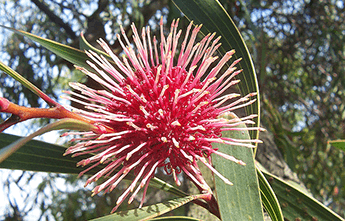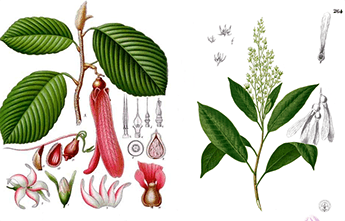- Mangroves
- Proteaceae
- Dipterocarpaceae
- Eucalyptus
- van Steenis






- Camptostemon schultzii
- Xylocarpus moluccensis
- Avicennia marina
- Nypa fruticans
- Heliciopsis
- Banksia
- Finschia
- Gevuina
- Grevillia
- Helicia
- Stenocarpus
- Oreocallis
- Macadamia
- Vatica
- Upuna
- Shorea
- Parashorea
- Anisoptera
- Hopea
- Dryobalanops
- Dipterocarpus
- Neobalanocarpus
- Cotylebobium
- Plant Genera Distribution
- Based on the analysis of van Steenis(1950)
- Flora Malesiana Vol.1 Land Plants
- Number of eastern centred genera
- Number of Endemic genera
The mangroves are a group of trees, shrubs, ferns, mistletoes and palms from several different plant families that occupy mudflats and estuaries on low energy coasts in the tropics and subtropics.
There are particularly well-developed mangrove forests (mangals) in intertidal areas in parts of South-east Asia, New Guinea and northern Australia. The mangroves have peculiar adaptations to saline conditions and low oxygen availability of the substrate (e.g. pneumatophores). Many of the mangrove species are widespread because they are able to disperse between islands, having buoyant propagules that are resistant to salt water.

The plant family Proteaceae is of Gondwanan origin and thus most representatives occur in South America, southern Africa and Australia. There are 73 species of Banksia (Proteaceae) in Australia, only one of which (Banksia dentata) reaches Papua New Guinea, West Papua and the Aru islands.
The genus Grevillea includes over 300 species with the greatest diversity in the south-west of Western Australia and along the Great Dividing Range. Three species occur in New Guinea and one species, Grevillea elbertii, is endemic to Sulawesi. A third genus of Proteaceae, Helicia, has spread as far as southern Asia and includes a range of species in New Guinea, Borneo and China. A single species, Helicia australasica, occurs in perenially wet rainforest patches in the Top End.

Source: WikiCommons
The dominant trees in Indomalayan lowland rainforests are frequently members of the family Dipterocarpaceae. Among the dipterocarps are emergent species that top the forest canopy, some being up to 50 metres high.
The greatest diversity of dipterocarps is in Borneo where there are 267 species. Dipterocarps are characterised by their winged fruit, however they are poor dispersers and the seeds often end up in close proximity to the mother tree. As a consequence they show a high degree of endemism. The pattern within Malesia is of strong concentration in the Sundaland rainforests with limited extension east of Wallace's line. Although three genera (Anisoptera, Hopea and Vatica) reach New Guinea, no species of dipterocarp occur naturally in Australia.

Source: WikiCommons
The eucalypts or gum trees (Eucalyptus and Corymbia; Family Myrtaceae) are an example of an endemic (autochthonous) evolutionary radiation in continental Australia. There are over 800 recognised species, most of which are endemic to Australia. About 12 species have colonised the south of New Guinea where they dominate the savanna woodlands.
There are three species on Timor and the Rainbow Gum Eucalyptus deglupta reaches Celebes and the southern Philipines. Two species (E. alba and E. urophylla) are known from as far west as Flores in the Lesser Sundas, and parts of Timor are vegetated with eucalypt woodlands. The myrtaceous paperbarks Melaleuca spp. are another Australian group that have a small number of species that are shared by northern Australia and New Guinea.

Photo prise à Ponteilla,
jardin exotique (France, Roussillon).
© Jean Tosti - Source Wikicommons
van Steenis (1950) analysed the distribution of plant (phanerogam or seed plants) genera in Malesia.
The number of endemic genera is highest on the large islands of Borneo and New Guinea. These islands are tropical and mountainous and have a wide range of habitats, thus providing opportunities for speciation.
The lowest number of endemic genera is in the islands of Nusa Tenggara and the Moluccas. The number of eastern-centred genera, i.e. genera derived from Australia or the Pacific, decreases from east to west, with the highest number of genera in New Guinea, and the lowest in the Malay Peninsula and Sumatra.